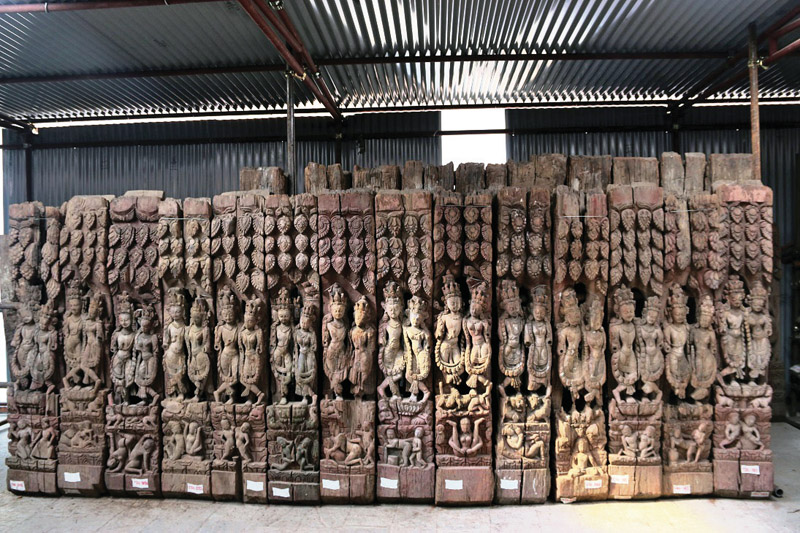Conservation based on savaged material
Much study is still required on the themes and craftsmanship
The sorting of wooden elements salvaged after the earthquake requires knowledge of the iconographic order as well as their structural function. For example, there is a clear order for the struts on various tiers of the temples. The struts have a main central section with exquisitely carved figures of various deities in human form. The struts have an upper section, which is filled with carvings often of floral or foliage motives. The lower parts, depending on the temple and the location of struts would have either scenes of everyday life, musical performances or erotic scenes. Much study is still required on the themes and craftsmanship.
After the devastation by the earthquake and aftershocks, the wooden elements from the 12 totally collapsed and some partially collapsed monuments at Hanuman Dhoka were piled up in 17 different locations. The wooden elements are now being sorted and cleaned by two national experts Mukunda Raj Aryal and Sukra Sagar Shrestha assisted by two master craftsmen Sushil Rajbhandari and Rakesh Birbal. Each element is being documented, registered into an inventory and then stored away in temporary sheds.
The correct reuse of salvaged materials has become the basic principle for reconstruction of monuments. We understand that this has always been the process. There is evidence that after the past earthquakes building elements have been reused.
The slow rehabilitation process consists of many considerations. It cannot be seen as purely the process of rebuilding structures. Heritage structures must be linked to a process of cultural rehabilitation and continuity. Even the dwellings and shelter must take into account the needs of the inhabitants in respect to physical, social, economic and cultural considerations.
An interesting example outside the Kathmandu, which explains this principle are the settlements that have been shifted in Upper Mustang due to the lack of water. When the water source dried out, the community determined a new location. The wooden elements would easily be removed from the earthen houses and be used to rebuild in the new location. The reuse of the wooden elements would predetermine the size of the new building ensuring continuity. Sadly, Upper Mustang seems to also have the worst examples of recent rehabilitation. In the name of equality, the community seems to have been provided with equal plots of land with identical houses in a row. All sense of community living and cultural continuity has been lost.
The reuse of material in post-earthquake reconstruction of collapsed monuments becomes imperative to ensure cultural continuity. Traditional construction materials retain their value even when the structure totally collapses. All the materials can be reused. Decorative elements that cannot be fixed still have value and can be placed in a museum. The broken bricks can be processed to brick dust.
The circumstances are very different when considering the waste created by many modern materials, in particular damaged reinforce cement concrete. Debris management becomes an entirely different process requiring heavy equipment and a site to dump the waste. The entire lifecycle of buildings must be taken in consideration when deciding on long-term solutions.
The author is an architect and can be contacted through paharnepal@hotmail.com






